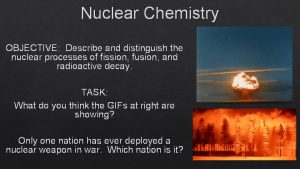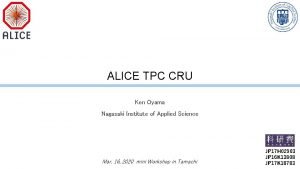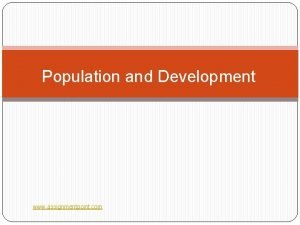Atomic Explosion at Nagasaki www assignmentpoint com Atomic














- Slides: 14

Atomic Explosion at Nagasaki www. assignmentpoint. com

Atomic explosion at Nagasaki, 9 August 1945. www. assignmentpoint. com

• Post-war division of the world was formalised by two international military alliances, the United States-led NATO and the Soviet-led Warsaw Pact; the long period of political tensions and military competition between them, the Cold War, would be accompanied by an unprecedented arms race and proxy wars. • In Asia, the United States led the occupation of Japan and administrated Japan's former islands in the Western Pacific, while the Soviets annexed Sakhalin and the Kuril Islands. • Korea, formerly under Japanese rule, was divided and occupied by the US in the South and the Soviet Union in the North between 1945 and 1948. Separate republics emerged on both sides of the 38 th parallel in 1948, each claiming to be the legitimate government for all of Korea, which led ultimately to the Korean War. www. assignmentpoint. com

• In China, nationalist and communist forces resumed the civil war in June 1946. Communist forces were victorious and established the People's Republic of China on the mainland, while nationalist forces retreated to Taiwan in 1949. • In the Middle East, the Arab rejection of the United Nations Partition Plan for Palestine and the creation of Israel marked the escalation of the Arab-Israeli conflict. While European colonial powers attempted to retain some or all of their colonial empires, their losses of prestige and resources during the war rendered this unsuccessful, leading to decolonisation. • The global economy suffered heavily from the war, although participating nations were affected differently. The US emerged much richer than any other nation; it had a baby boom and by 1950 its gross domestic product person was much higher than that of any of the other powers and it dominated the world economy. • The UK and US pursued a policy of industrial disarmament in Western Germany in the years 1945– 1948. • Due to international trade interdependencies this led to European economic stagnation and delayed European recovery for several years. www. assignmentpoint. com

• Recovery began with the mid-1948 currency reform in Western Germany, and was sped up by the liberalization of European economic policy that the Marshall plan (1948– 1951) both directly and indirectly caused. • The post 1948 West German recovery has been called the German economic miracle. Also the Italian and French economies rebounded. • By contrast, the United Kingdom was in a state of economic ruin, and although it received a quarter of the total Marshall Plan assistance, more than any other European country, continued relative economic decline for decades. • The Soviet Union, despite enormous human and material losses, also experienced rapid increase in production in the immediate post-war era. • Japan experienced incredibly rapid economic growth, becoming one of the most powerful economies in the world by the 1980 s. China returned to its pre-war industrial production by 1952. www. assignmentpoint. com

Impact Casualties and war crimes Main articles: World War II casualties and War crimes during World War II deaths www. assignmentpoint. com

Chinese civilians to be buried alive by Japanese soldiers. • Roughly 7. 5 million civilians died in China under Japanese occupation. Hundreds of thousands (varying estimates) of ethnic Serbs, along with gypsies and Jews, were murdered by the Axisaligned Croatian Ustaše in Yugoslavia, with retributionrelated killings of Croatian civilians just after the war ended. www. assignmentpoint. com

• The best-known Japanese atrocity was the Nanking Massacre, in which several hundred thousand Chinese civilians were raped and murdered. Between 3 million to more than 10 million civilians, mostly Chinese, were killed by the Japanese occupation forces. • Mitsuyoshi Himeta reported 2. 7 million casualties occurred during the Sankō Sakusen. General Yasuji Okamura implemented the policy in Heipei and Shantung. • The Axis forces employed limited biological and chemical weapons. The Italians used mustard gas during their conquest of Abyssinia, while the Imperial Japanese Army used a variety of such weapons during their invasion and occupation of China (see Unit 731)and in early conflicts against the Soviets. • Both the Germans and Japanese tested such weapons against civilians and, in some cases, on prisoners of war. www. assignmentpoint. com

• While many of the Axis's acts were brought to trial in the world's first international tribunals, incidents caused by the Allies were not. Examples of such Allied actions include population transfers in the Soviet Union and Japanese American internment in the United States; the Operation Keelhaul, expulsion of Germans after World War II. rape during the occupation of Germany; the Soviet Union's Katyn massacre, for which Germans faced counter-accusations of responsibility. • Large numbers of famine deaths can also be partially attributed to the war, such as the Bengal famine of 1943 and the Vietnamese famine of 1944– 45. Brutalised by war and fuelled by racist propaganda, many American soldiers in the Pacific mutilated corpses and kept grizzly war trophies. • It has been suggested by some historians, e. g. Jörg Friedrich, that the mass-bombing of civilian areas in enemy territory, including Tokyo and most notably the German cities of Dresden, Hamburg and Cologne by Western Allies, which resulted in the destruction of more than 160 cities and the deaths of more than 600, 000 German civilians be considered as war crimes. www. assignmentpoint. com

• Concentration camps and slave work • Further information: The Holocaust, Consequences of Nazism, Japanese war crimes, and Allied war crimes during World War II • The Nazis were responsible for The Holocaust, the killing of approximately six million Jews (overwhelmingly Ashkenazim), as well as two million ethnic Poles and four million others who were deemed "unworthy of life" (including the disabled and mentally ill, Soviet prisoners of war, homosexuals, Freemasons, Jehovah's Witnesses, and Romani) as part of a programme of deliberate extermination. About 12 million, most of whom were Eastern Europeans, were employed in the German war economy as forced labourers. www. assignmentpoint. com

• In addition to Nazi concentration camps, the Soviet gulags (labour camps) led to the death of citizens of occupied countries such as Poland, Lithuania, Latvia, and Estonia, as well as German prisoners of war (POWs) and even Soviet citizens who had been or were thought to be supporters of the Nazis. • Sixty percent of Soviet POWs of the Germans died during the war. Richard Overy gives the number of 5. 7 million Soviet POWs. Of those, 57 percent died or were killed, a total of 3. 6 million. • Soviet ex-POWs and repatriated civilians were treated with great suspicion as potential Nazi collaborators, and some of them were sent to the Gulag upon being checked by the NKVD. www. assignmentpoint. com

• Japanese prisoner-of-war camps, many of which were used as labour camps, also had high death rates. The International Military Tribunal for the Far East found the death rate of Western prisoners was 27. 1 percent (for American POWs, 37 percent), seven times that of POWs under the Germans and Italians. • While 37, 583 prisoners from the UK, 28, 500 from the Netherlands, and 14, 473 from United States were released after the surrender of Japan, the number for the Chinese was only 56. • According to historian Zhifen Ju, at least five million Chinese civilians from northern China and Manchukuo were enslaved between 1935 and 1941 by the East Asia Development Board, or Kōain, for work in mines and war industries. www. assignmentpoint. com

• After 1942, the number reached 10 million. The U. S. Library of Congress estimates that in Java, between 4 and 10 million romusha (Japanese: "manual laborers"), were forced to work by the Japanese military. About 270, 000 of these Javanese laborers were sent to other Japanese-held areas in South East Asia, and only 52, 000 were repatriated to Java. • On 19 February 1942, Roosevelt signed Executive Order 9066, interning thousands of Japanese, Italians, German Americans, and some emigrants from Hawaii who fled after the bombing of Pearl Harbor for the duration of the war. The U. S. and Canadian governments interned 150, 000 Japanese-Americans, In addition, 14, 000 German and Italian residents of the U. S. who had been assessed as being security risks were also interned. www. assignmentpoint. com

In accordance with the Allied agreement made at the Yalta Conference millions of POWs and civilians were used as forced labor by the Soviet Union. In Hungary's case, Hungarians were forced to work for the Soviet Union until 1955. • GDP if Japanese colonies are included. In Europe, before the outbreak of the war, the Allies had significant advantages in both population and economics. • In 1938, the Western Allies (United Kingdom, France, Poland British Dominions) had a 30 percent larger population and a 30 percent higher gross domestic product than the European Axis (Germany and Italy); if colonies are included, it then gives the Allies more than a 5: 1 advantage in population and nearly 2: 1 advantage in GDP. www. assignmentpoint. com
 Cơm
Cơm Bài thơ mẹ đi làm từ sáng sớm
Bài thơ mẹ đi làm từ sáng sớm Shadows from hiroshima
Shadows from hiroshima Nagasaki location
Nagasaki location Nagasaki sorting algorithm
Nagasaki sorting algorithm Www.assignmentpoint.com
Www.assignmentpoint.com Assignmentpoint.com
Assignmentpoint.com Assignmentpoint.com bangladesh
Assignmentpoint.com bangladesh Glibbering
Glibbering Assignmentpoint
Assignmentpoint Sequence diagram for add calendar appointment
Sequence diagram for add calendar appointment Assignmentpoint
Assignmentpoint Www.assignmentpoint.com
Www.assignmentpoint.com The income elasticity of demand
The income elasticity of demand Assignmentpoint.com
Assignmentpoint.com


























